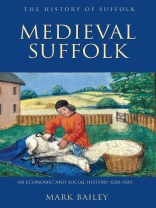A comprehensive survey of the economy and society of late medieval Suffolk.
Suffolk was one of the most important regions of England in the middle ages. Even by 1200 it was wealthy, densely populated, highly commercialised and urbanised; and it survived the impact of three of the most tumultuous events ofthe last millennium, the Great Famine (1315-22), the Black Death (1349) and the Peasants’ Revolt (1381), to become by 1500 one of the richest and most industrialised regions of England, based on cloth manufacture, fishing and tanning.
This volume describes, documents and analyses these events. It combines an accessible and readable summary of the current state of knowledge with fresh insights drawn from extensive investigations of primary sources. Overall, it offers a guide to and re-evaluation of the history of late medieval Suffolk.
قائمة المحتويات
Introduction
Landlords and their Estates, 1200-1349
Peasants and their Lifestyles, 1200-1349
The Agrarian Economy, 1200-1349
The Suffolk Landscape, 1200-1349
Towns and the Urban Environment
Commerce, Crafts and Industry
Pestilence, Rebellion and Villeinage, 1349-1500
The Rural Economy, 1350-1500
`The World Turned Upside Down’: Rural Society, 1350-1500
Towns, Trade and Industry, 1350-1500
Conclusion
عن المؤلف
MARK BAILEY was recently High Master of St Paul’s School, London, and a visiting fellow of All Souls College, Oxford. He was previously a fellow of Corpus Christi College, Cambridge, and is now the Professor of Later Medieval History at the University of East Anglia. His numerous publications include Medieval Suffolk. An economic and social history 1200-1500 (2007) and After the Black Death. Economy, society and the law in fourteenth-century England (2021).












